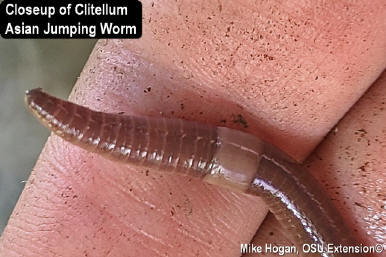 Jumping worms (Amynthas) are a relatively new invasive species of worms that originated in Asia. As their name implies, they jump and wiggle and are very active worms. Jumping worms are bad news for gardeners because they strip the soil of nutrients and can kill plants. The invasive Asian jumping worms have been spotted in Adams County and other counties in Pennsylvania along with other areas in the Mid-Atlantic, Midwest, and some Northwestern states and are spreading rapidly.
Jumping worms (Amynthas) are a relatively new invasive species of worms that originated in Asia. As their name implies, they jump and wiggle and are very active worms. Jumping worms are bad news for gardeners because they strip the soil of nutrients and can kill plants. The invasive Asian jumping worms have been spotted in Adams County and other counties in Pennsylvania along with other areas in the Mid-Atlantic, Midwest, and some Northwestern states and are spreading rapidly.
Because jumping worms prefer living in damp leaf litter and soil with high levels of organic matter, they are commonly found in gardens, mulched areas, low-temperature compost material, irrigated yards and fields, and forests. They are ravenous eaters that quickly consume the organic matter from the soil and prevent water infiltration. A sure sign of an infestation of jumping worms is when the texture of the soil is comparable to coffee grounds.
Soil disruption from jumping worms can diminish the growth of annuals, perennials, shrubs, and trees. Native plants, insects, and birds can suffer from the consequences of the destruction from jumping worms. They disrupt forest ecosystems by displacing native organisms and by making the topsoil where they live less favorable for native understory plants. Jumping worms are more ravenous eaters than the European earthworms. They establish themselves quickly in a new location.
Jumping worms have an annual life cycle. The adults die after the first hard frost because they live near the surface of the soil. However, the next generation survives the winter in the form of cocoons (egg casings). They hatch when the soil temperature is consistently above 50 degrees and will develop into full-size adults in 60 days. Climate change is starting to increase the number of generations to two per year. The cycle continues from year to year. Unfortunately, individual worms can reproduce without a mate (parthenogenesis) so their population increases rapidly.
Jumping worms are similar in size to the common European earthworms and nightcrawlers. But there are differences in these worms so be vigilant to be able to distinguish the jumping worms from other worms. Remember that the European earthworms and nightcrawlers in our area are very beneficial for our soil so it is imperative to be able to identify the European worms from the jumping worms and learn how to properly destroy the jumping worms.
What are the distinguishing characteristics of the jumping worm?
- The clitellum (collar-like ring) located 1/3 the length down from the worm from the head, is smooth, cloudy white in appearance and wraps entirely around the body. The clitellum on other earthworms is reddish-brown and it is farther from the head. The clitellum may not completely encircle the body on the common European earthworms.
- They move across the ground in an "S" movement like a snake.
- Asian jumping worms are smooth but not slimy to the touch. When disturbed these worms flail about wildly. A European earthworm is generally slimy to the touch and will coil into a ball or flatten its body when touched.
What precautions can be taken to prevent jumping worm infestation?
- Do not buy or use jumping worms for bait, vermicomposting, or gardening!
- Prior to planting any plants that you purchase or are given from a friend, rinse the soil from the plants and collect the water in a bucket. Place the bucket of water outside on concrete or blacktop and cook the water in the sun prior to discarding the water in case there are jumping worms or cocoons in the soil.
- Buy bare root stock when possible.
- Jumping worms and their cocoons can be in mulch so purchase mulch from a reputable producer that heats the mulch to at least 130 degrees for at least 3 days before selling the mulch or in the alternative, purchase bagged mulch.
What measures can be taken if the soil becomes infested with jumping worms?
- Handpick the jumping worms from the soil, place them in a plastic bag in the sun for at least 10 minutes or place them in a plastic bag with vinegar or rubbing alcohol. Then dispose of the bag of worms in the trash. Do not compost them or bury them.
- Never dissect the jumping worms because the pieces will reproduce into more jumping worms!
- An organic fertilizer made of tea meal can be used to kill jumping worms. This would be applied in April or May to kill newly hatched worms and again in the summer.
- The best management approach is to analyze your yard and garden often for the jumping worms. They are especially easy to spot when they surface after a good rain. If they are discovered, follow the instructions by placing them in a plastic bag and destroying them. While there is ongoing research to develop biological control and chemical management options, it is unlikely that this will be available to homeowners for several years.
Educate your family and friends about jumping worms so that they can identify them and reduce their spread. Never purchase "jumping worms," "crazy snake worms," "Asian crazy worms," or "Alabama jumpers" for use in vermicomposting, as pet food, or as fishing bait.
Be vigilant to decrease the spread of invasive jumping worms and take responsibility for improving the environment we have been blessed to enjoy and maintain.